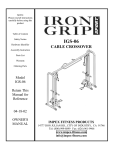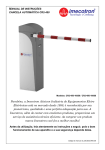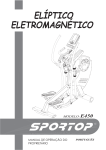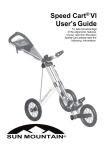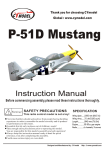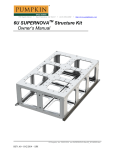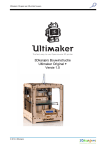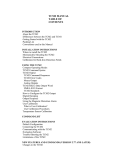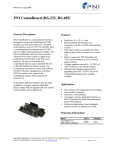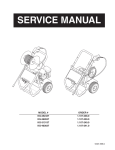Download Tank main shaft seal replacement service guide
Transcript
Tank disassembly and service guide E520/E720/E820E920 Note to Service Technician: This service guide covers complete tank disassembly with special emphasis on main-shaft/flywheel removal and tank seal replacement. Inquiries regarding PC tank adjuster shaft or adjuster plate service can be found in the appropriate service manual. Mainshaft seal spring report From the start of production, the FDF Fluid Tank has relied on a spring reinforced seal to prevent leakage along the main shaft. This has been extremely reliable over five years of manufacture In 2006, we switched to a new tank back system, choosing a fibre reinforced resin material (SMC) which was more durable than aluminum. Extensive testing for 12 months did not produce a single failure. We released the S250/S350 models in late 2006 and, in about 8 months, began to experience the occasional failure through the tank main shaft seal. The cases were few enough at the time to write it off to manufacturing error, although extensive testing of both in-house SOP’s and parts tolerances turned up nothing unusual. The problem was confined to these models. However, towards the end of 2008, we began to experience occasional main shaft seal failures on other products. Again, we examined our manufacturing process and found nothing. Yet the complaints continued. In late March 2009, we swapped what seemed at the time to be the hundredth tank onto the test machine. But this tank was to provide the break through we’d been seeking. With less than 50 hours of usage, this tank had a telltale puddle of rusty water at the rear of our E316 test unit’s tank shaft. We pulled it apart, and discovered a rust colored stain on the inner rim of the main shaft seal. Taking out the spring was a revelation...Instead of our specified stainless steel spring (shown middle, lower right) we instead discovered a mild steel spring (shown upper right) that had failed due to minor corrosion. This was the answer we’d been seeking. The slightly corroded spring could not handle the minute oscillations of the main shaft and allowed water to seep along the main shaft into the bearing housing. We immediately contacted the supplier, who confirmed that this was indeed not a stainless steel spring. From this date onward, we have been using only stainless steel springs (as we had for the first 5 years). And since this date, we’ve not received a single warranty claim for tank failure on any product manufactured after this fault was discovered. We are completely certain that this is the source of the leaking tanks and now only use stainless steel springs inside our main shaft seals. We have procedures in place to prevent this happening again and apologise for the inconvenience it has caused a number of our distributors. Corroded, non stainless spring quickly loses ability to maintain shape, causing just enough distortion of the seal to allow seepage along the mainshaft through to the bearings. A correct spec stainless steel mainshaft seal spring after 6 months in water, and 4 years after production, alongside our current stainless spring. As pictured, the springs are identical . Small belt pulley removal prep: Step 2: Flip the tank over to access the mainshaft/belt pulley Step 3: Using a screwdriver or suitable tool, lock the impeller blade in place and remove the rear main-shaft bolt. Step 1: Remove the adjuster handle grub screws and remove handle from adjuster shaft. Small Pulley Removal: Step 4: Remove Main shaft rear bolt and washer. Step 6: With a standard bearing puller, begin threading the pulley off the main shaft. Once the pulley has some clearance away from the rear of the aluminum housing, reposition the bearing puller to the bottom of the pulley for easer removal as shown below. Step 5: Screw a M10x (at least 70mm)bolt into the main-shaft. Main shaft shown after small pulley, keyway, washer and bolt removal. Tank main shaft seal replacement service guide: Note to Service Technician: This service guide is applicable to all First Degree Products using the Multi-level resistance tank.; which includes the following products manufactured after March of 2006…(For details regarding older equipment, please consult the service notes regarding the aluminum tank.) 1. 2. 3. 4. S-500 UBE Cycle XT S-350/S-250 Evolution series: 1. E-520 2. E-720/820/920 3. E-316/216 The service guide is for main-shaft seal replacement only, and assumes the tank has been removed from the machine and pulleys/sprockets removed. For further details regarding specific product tank removal and service, please consult the appropriate model specific section of the service manual. The seal replacement kit consists of the following parts: 1x 2x 1x 1x #10025 NBR tank shaft seal #10012 6005ZZ NSK bearing #10145 Bearing Spacer #10186 C-clip Removing the PC tank cover Step 1 Step 2 Step 3 Step 4 Start by removing Polycarbonate shell. Once the M3x12mm tank screws (12x) have been removed, use a rubber mallet and drop cloth and tap gently to break loose the outer tank seal. Remove the upper section of the tank, and inspect the O-ring for any signs of cracking tearing or binding. Replace if needed. Removing the flywheel/main shaft Next, flip the tank back over and find a suitable location to drive the flywheel mainshaft through as pictured; such as the ends of two tables, workbenches or even two chairs. Use a rubber mallet to drive the mainshaft through the tank-back. Screw a M10 bolt into the mainshaft rear to help drive the mainshaft out as shown. Note: The flywheel mainshaft is heavy. Allow the assembly to drop onto a soft surface underneath. The impeller blades are also sharp, use care when handling. Removing the flywheel/main shaft with the FDF Flywheel shaft puller P/N13300 First, attach the FDF flywheel shaft puller to the rear of the SMC tank aluminum housing and tighten the four bolts as shown. Then, with a large open-end or crescent wrench, slowly turn the main puller bolt clock-wise until the flywheel is forced through the housing and out of the tank. Note: Use a towel or other soft surface underneath to avoid damage when the flywheel/mainshaft assembly drops out of the housing. Step 3: Step 1: Step 4: Step 2: Tank shaft seal Inspection: On the left is a healthy tank shaft seal, the silicone glue and packing grease maintain their original color. The integrity of this tank shaft seal has not been compromised. The bearings will show no sign of water damage and run smoothly. If there are no issues with the tank bearings, the bearings and tank shaft seal can be left in place and the tank reassembled. The right seal has been compromised. Telltale signs are the discolored silicone and the propensity for the tank seal to pop out of position when the main-shaft/ flywheel assembly is removed. The seal (part number 10025) tank bearings (part number 10012) spacer (part number 10145) and Cclip (part number 10186) will be replaced in the tank shaft seal kit. Removing the tank bearings and tank 4. Tap out the front bearing and remove 1. Remove C-clip from rear of aluminum housing 2. With small drift and hammer, lightly tap out and remove the rear bearing 5. Lightly tap out the mainshaft seal and remove 3. Remove Rear bearing and spacer Replacing the tank bearings 1. Clean inside of aluminum housing. Add thread locker to the outside of the bearing and to the inside of the aluminum housing where the two bearings will be located. Note that the service tech will be required to rig up a tool of some kind to tap the front tank bearing in. An example of the set up we use at the factory is shown below. A simple washer and metal spacer will also work. Check that the bearings are rotating smoothly once seated in the housing. 2. Replace Spacer. 4. Replace C-clip 3. Replace rear bearing Replacing the tank shaft seal: 1.Carefully remove any residual matter (silicone glue or grease from the SMC seal housing walls before pressing in the new seal housing. 2. Apply silicone glue to the outside of the NBR tank seal prior to pressing the seal into the SMC tank back. Standard fish tank grade Silicone is required. 3. Tap the seal into place lightly with a rubber mallet until flush with SMC. The excess silicone glue will be pushed upward from the sidewall between the seal and SMC seal housing. With your finger, use this excess silicone to create an extra barrier by covering the an area extending approx 2cm from the outer SMC wall with the excess silicone, paying special attention to the “lip” area of the housing. Then clean out any remaining silicone located between the “lips” of the seal before proceeding. Allow a few minutes for the initial setup of the silicone glue before moving on to the silicone packing grease. Silicone Grease Packing: Apply a generous amount of Silicone grease (standard O-ring grease) to the inside of the seal and pack the area between the rear of the seal and the front bearing with a liberal amount of O-ring grease. Above right is an example of a properly prepared tank shaft seal . Cup seal addendum: This addendum affects all FDF9E kits for the following products: E216/E316/E520/E720/E820/E920, and the S250/S350 series rowers. Once the bearings, mainshaft seal and spacer have been replaced, this cup seal slides onto the mainshaft as shown bottom left and right before the flywheel shaft is re-installed through the SMC tank back (as directed in the service notes). Shown upper right (without the flywheel mainshaft for effect) is the cup seal. It will help direct water away from the mainshaft seal, thus reducing wear and tear and greatly extending the longevity of the replacement parts. This is especially helpful for the S250/S350 series rowers. Note distributors holding existing FDF9E kits without the cup seal can order them (Part number #13025) FOC by contacting our Production Manager in Taiwan (Note freight charges are the responsibility of the Distributor), Michael Botti. Email address as follows: [email protected]. Tel: 886 3 478 3306 ext#45 Slide the cup seal onto the flywheel mainshaft juts prior to reassembly as shown: Reinstalling the flywheel/main shaft 1. Apply axle grease to main shaft before installation. Note: When pressing the main shaft into the SMC tank back, make sure the bearing spacer is aligned. 2. Once the Flywheel/ Main shaft assembly has been completed, you may proceed with reinstalling the tank cover O-ring, PC cover and finally whichever drive system is applicable for the tank in question. Reinstalling the Tank O-ring and Polycarbonate cover 1. Lay the O-ring into the SMC O-ring groove, making sure it is flat and flush before securing the PC cover. An improperly laid and prepared Oring will seep water over time. If the seal is excessively dry, then add a light coat of silicone grease. 2. When attaching the PC cover, use a cross pattern with the screws. If a power tool is used, the lightest setting is more than enough to establish a seal. Note over tightening the tank screws will readily crack the PC cover! Reinstalling the small belt pulley, keyway and bolt 1. Reinstall the Small belt pulley onto the main-shaft. Remember to keep the keyway positions on the shaft and pulley lined up as you go. 3. The Keyway, small pulley and main-shaft assembly. To finish, reinstall the washer, spring washer and tank shaft bolt 2. Apply thread locker to the keyway before knocking into place. Use a drift or heavy bladed screwdriver to drive the keyway into place as shown upper right.

















